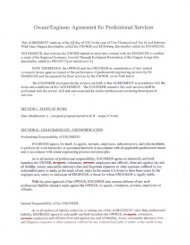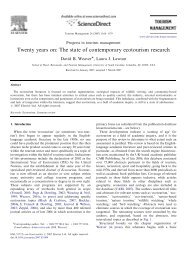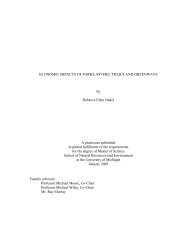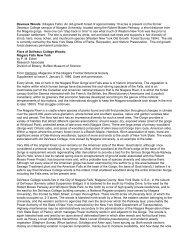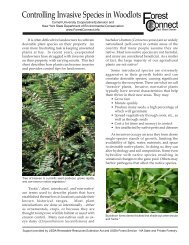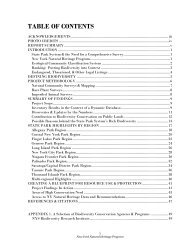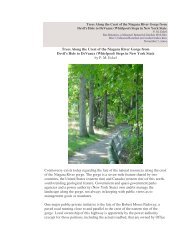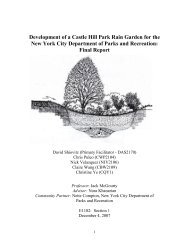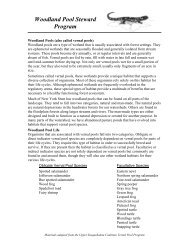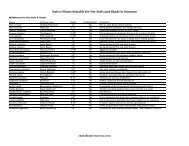Some Remarks on the Socio-Cultural Background of Restoration ...
Some Remarks on the Socio-Cultural Background of Restoration ...
Some Remarks on the Socio-Cultural Background of Restoration ...
Create successful ePaper yourself
Turn your PDF publications into a flip-book with our unique Google optimized e-Paper software.
<strong>Socio</strong>-<strong>Cultural</strong> <strong>Background</strong> <strong>of</strong> Restorati<strong>on</strong> Ecology<br />
ti<strong>on</strong>ship between <strong>the</strong> successful implementati<strong>on</strong> <strong>of</strong> restorati<strong>on</strong><br />
goals <strong>on</strong> <strong>the</strong> <strong>on</strong>e hand, and pr<strong>of</strong>essi<strong>on</strong>al marketing<br />
<strong>of</strong> products <strong>on</strong> <strong>the</strong> o<strong>the</strong>r. In <strong>the</strong> agricultural<br />
sector, <strong>the</strong> local and regi<strong>on</strong>al marketing <strong>of</strong> meat, cheese,<br />
potatoes, etc., can lead to a situati<strong>on</strong> where expensive<br />
(labor-intensive) products from extensive agriculture<br />
are preferentially purchased, thus c<strong>on</strong>tributing to <strong>the</strong><br />
stabilizati<strong>on</strong> <strong>of</strong> such land use systems (Knauer 1993).<br />
For example, organic farming has proved to be ec<strong>on</strong>omically<br />
and ecologically sustainable (Pommer 1990), especially<br />
in densely populated areas and when combined<br />
with user-friendly marketing strategies (for instance,<br />
home deliveries). The financial promoti<strong>on</strong> <strong>of</strong> such systems<br />
could be an impetus for <strong>the</strong> spatial implementati<strong>on</strong><br />
<strong>of</strong> nature c<strong>on</strong>servati<strong>on</strong> goals.<br />
A fur<strong>the</strong>r example is that <strong>of</strong> <strong>the</strong> permanent inundati<strong>on</strong><br />
<strong>of</strong> extremely degraded fens (Pfadenhauer & Grootjans<br />
1999). The resulting highly productive reed stands<br />
<strong>of</strong> Typha (Cattail) species or Phragmites australis (Comm<strong>on</strong><br />
Reed) can be used for growing raw materials for<br />
<strong>the</strong> manufacture <strong>of</strong> insulati<strong>on</strong> plates in <strong>the</strong> building industry.<br />
Given <strong>the</strong> ec<strong>on</strong>omy <strong>of</strong> such a product, envir<strong>on</strong>mentally<br />
political goals—such as <strong>the</strong> activati<strong>on</strong> <strong>of</strong> fens<br />
for material sinks or <strong>the</strong> minimizati<strong>on</strong> <strong>of</strong> <strong>the</strong> emissi<strong>on</strong>s<br />
<strong>of</strong> climatically relevant trace gases—can be combined<br />
with an utilitarian goal. This can represent an alternative<br />
for farmers (Wichtmann & Koppisch 1998).<br />
Financial Rewards for Envir<strong>on</strong>mental Achievements<br />
Intelligent marketing strategies are never<strong>the</strong>less insufficient<br />
<strong>on</strong> <strong>the</strong>ir own. As previously menti<strong>on</strong>ed, most comp<strong>on</strong>ents<br />
<strong>of</strong> <strong>the</strong> Central European cultural landscape<br />
which are worthy <strong>of</strong> protecti<strong>on</strong> are <strong>the</strong> result <strong>of</strong> historic<br />
land uses. If it were possible to modify existing land use<br />
systems so <strong>the</strong>y corresp<strong>on</strong>ded to <strong>the</strong> goals <strong>of</strong> nature c<strong>on</strong>servati<strong>on</strong><br />
policy, or to establish such land use systems,<br />
<strong>the</strong> acceptance <strong>of</strong> nature c<strong>on</strong>servati<strong>on</strong> goals and <strong>the</strong>ir implementati<strong>on</strong><br />
efficiency could be greatly increased. In this<br />
way, agriculture in cultural landscapes would develop a<br />
dual functi<strong>on</strong>; it would produce not <strong>on</strong>ly foodstuffs, but<br />
also envir<strong>on</strong>mental “achievements.” This includes <strong>the</strong><br />
supply <strong>of</strong> drinking water for urbanized areas, a structurally<br />
rich landscape for recreati<strong>on</strong>, but also <strong>the</strong> protecti<strong>on</strong><br />
and development <strong>of</strong> <strong>the</strong> regi<strong>on</strong>al species pool. Such envir<strong>on</strong>mental<br />
achievements must be financially rewarded,<br />
preferably by <strong>the</strong> citizens who benefit from <strong>the</strong>m.<br />
Ways <strong>of</strong> achieving such a system <strong>of</strong> “transfer payments”<br />
are presently a matter <strong>of</strong> c<strong>on</strong>troversy (H<strong>of</strong>mann<br />
et al. 1995). C<strong>on</strong>tractual nature c<strong>on</strong>servati<strong>on</strong>, which is<br />
usual in Germany, is a first step in this directi<strong>on</strong>. However,<br />
<strong>the</strong>re is still a lack <strong>of</strong> viable valuati<strong>on</strong> systems with<br />
which <strong>the</strong> achievement <strong>of</strong> an agricultural enterprise and<br />
<strong>the</strong> level <strong>of</strong> <strong>the</strong> fee could be determined. Here, <strong>the</strong>re is<br />
much research to be d<strong>on</strong>e. I would like briefly to describe<br />
this complex <strong>of</strong> requirements using an example <strong>of</strong> reestablishment<br />
<strong>of</strong> calcareous grassland: a grassland development<br />
c<strong>on</strong>cept for <strong>the</strong> nor<strong>the</strong>rn Munich Gravel Plain.<br />
Case Study 3: A Grassland C<strong>on</strong>cept for <strong>the</strong> Nor<strong>the</strong>rn<br />
Munich Gravel Plain<br />
The Munich Gravel Plain is situated in sou<strong>the</strong>rn Germany at<br />
<strong>the</strong> foot <strong>of</strong> <strong>the</strong> Alps. It c<strong>on</strong>sists <strong>of</strong> late glacial gravels with high<br />
water permeability, sedimented by smeltwaters <strong>of</strong> <strong>the</strong> last ice<br />
age. The sediments are up to 40 m deep in <strong>the</strong> south, and level<br />
out over tertiary clay toward <strong>the</strong> north. The soils are shallow<br />
pararendzinas. Until <strong>the</strong> middle <strong>of</strong> <strong>the</strong> last century, this<br />
sparsely populated area was characterized by <strong>the</strong> presence <strong>of</strong><br />
about 150 km 2 <strong>of</strong> species-rich calcareous grassland (Ad<strong>on</strong>ido vernalis-Brachypodietum<br />
rupestris; Pott 1995b) which had developed<br />
from park-like groves <strong>of</strong> Pinus sylvestris and Quercus robur as a<br />
result <strong>of</strong> grazing and fire (Fig. 4, right).<br />
Owing to <strong>the</strong> intensificati<strong>on</strong> <strong>of</strong> agriculture, most <strong>of</strong> <strong>the</strong> area<br />
was afforested, or alternatively was fertilized with sewage<br />
sludge from <strong>the</strong> city <strong>of</strong> Munich and c<strong>on</strong>verted into arable land<br />
(Fig. 4, left). Military training areas were established <strong>on</strong> fields<br />
which could not be ameliorated. The greater part <strong>of</strong> this grassland<br />
had been transformed by 1928. Since <strong>the</strong> Sec<strong>on</strong>d World<br />
War, <strong>the</strong> nor<strong>the</strong>rn Munich Gravel Plain has been subjected to<br />
rapid industrial and residential expansi<strong>on</strong>. The commissi<strong>on</strong>ing<br />
<strong>of</strong> <strong>the</strong> new Munich Airport “Franz Joseph Strauss” forced<br />
additi<strong>on</strong>al development <strong>of</strong> <strong>the</strong> infrastructure. Today, <strong>the</strong> regi<strong>on</strong><br />
has <strong>the</strong> lowest unemployment rate in all <strong>of</strong> Germany.<br />
However, <strong>the</strong>re are <strong>on</strong>ly a few areas remaining to serve as a<br />
reminder <strong>of</strong> <strong>the</strong> former widespread grassland. These include<br />
<strong>the</strong> nature reserve Garchinger Heide, as well as porti<strong>on</strong>s <strong>of</strong><br />
former military training areas which are already floristically<br />
depleted. The nature reserve Garchinger Heide features some<br />
240 phanerogams over an area <strong>of</strong> about 27 ha and is <strong>the</strong> <strong>on</strong>ly<br />
example <strong>of</strong> c<strong>on</strong>tinental grassland steppe in Germany south <strong>of</strong><br />
<strong>the</strong> Danube, characterized by species such as Ad<strong>on</strong>is vernalis<br />
(Pheasant’s Eye), Linum perenne (Perennial Flax) and Pulsatilla<br />
patens (Pasque Flower).<br />
In 1990, <strong>the</strong> municipalities <strong>of</strong> <strong>the</strong> nor<strong>the</strong>rn Munich Gravel<br />
Plain combined to form a heathland preservati<strong>on</strong> society, <strong>the</strong><br />
Heideflächenverein. The aim <strong>of</strong> <strong>the</strong> society is to raise <strong>the</strong> value<br />
<strong>of</strong> this highly pressured and industrialized regi<strong>on</strong>, both for local<br />
recreati<strong>on</strong> and nature c<strong>on</strong>servati<strong>on</strong>. This has resulted in a<br />
restorati<strong>on</strong> plan which attempts to meet some <strong>of</strong> <strong>the</strong> abovementi<strong>on</strong>ed<br />
requirements. Two main tasks shall be fulfilled:<br />
• Grassland extensi<strong>on</strong>: formerly agriculturally-used allotments<br />
were purchased, leased or voluntarily made available<br />
by <strong>the</strong> landowners <strong>the</strong>mselves, and c<strong>on</strong>verted into<br />
grassland using a special procedure (importati<strong>on</strong> <strong>of</strong> hay<br />
material <strong>on</strong>to fallow areas; Miller & Pfadenhauer 1997).<br />
• Grassland network: <strong>the</strong> spatially-isolated old and new<br />
grassland areas were interc<strong>on</strong>nected by sheep tracks so<br />
that all areas could be grazed as part <strong>of</strong> stati<strong>on</strong>ary shepherding<br />
(i.e., with fixed sheepfolds outside <strong>of</strong> <strong>the</strong> grassland<br />
and additi<strong>on</strong>al, fertilized pastures to cover <strong>the</strong> basic nutriti<strong>on</strong>al<br />
requirements). In this way, <strong>the</strong> areas were functi<strong>on</strong>ally<br />
interc<strong>on</strong>nected by seed transport, carried in <strong>the</strong> wool<br />
<strong>of</strong> <strong>the</strong> sheep (Wiesinger & Pfadenhauer 1998).<br />
226 Restorati<strong>on</strong> Ecology JUNE 2001



